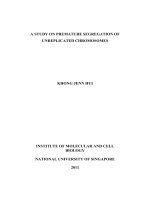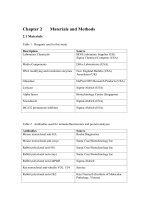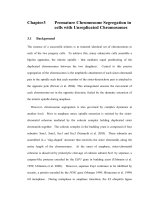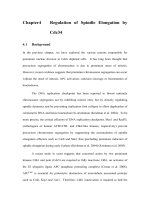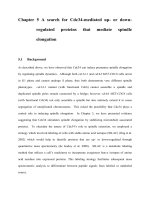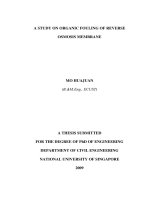A study on physico-chemical properties of Uthukuli Ghee
Bạn đang xem bản rút gọn của tài liệu. Xem và tải ngay bản đầy đủ của tài liệu tại đây (353.32 KB, 10 trang )
Int.J.Curr.Microbiol.App.Sci (2019) 8(4): 2090-2099
International Journal of Current Microbiology and Applied Sciences
ISSN: 2319-7706 Volume 8 Number 04 (2019)
Journal homepage:
Original Research Article
/>
A Study on Physico-Chemical Properties of Uthukuli Ghee
S. Bhavani Ramya1, D. Baskaran2*, K. Vijayarani3, R. Palanidorai4 and D. Ramasamy5
1
College of Food and Dairy Technology, College of Food and Dairy Technology (TANUVAS),
Koduveli, Chennai- 52, India
2
Department of Livestock Technology (Dairy Science), 3Department of Animal Biotechnology,
4
Department of Livestock Technology (Dairy Science), MVC, Chennai- 52, India
5
Directorate of Extension Education, MMC, Koduveli, Chennai- 52, India
*Corresponding author
ABSTRACT
Keywords
Ghee, Geographical
nature, Physicochemical properties,
Nutritional
composition
Article Info
Accepted:
15 March 2019
Available Online:
10 April 2019
Ghee is known as valuable natural source of food that has numerous health benefits
entirely beneficial to the human population. It is one of the popular ingredients in the
Indian diet and takes infinitely prevalent position in the dairy industry market. The
geographical production makes curious difference in the physico-chemical properties,
flavour uniqueness, sensory and storage stability parameters. Concentrating on the
geographically important ghee, uthukuli ghee from region of TamilNadu is known for its
extraordinary flavour. Exclusiveness in ghee production is primarily dependent on the area
of production, breed of animal, feed used for the animals, temperature and other intrinsic,
extrinsic factors. In this paper, physico-chemical parameters such as Reichert- Meissl (Rm)
value, Polenske value, Iodine value, Saponification value (SV), Butyro-refractometer (BR)
reading, Melting Point, Free fatty acid (FFA), peroxide value, Critical Temperature of
Dissolution (CTD) have been determined for geographically relevant uthukuli ghee.
Introduction
‘Ghee’ the popularly known constantly
focused dairy product that showcases
predominant health concerns and has basic
etiquette in Indian culinary. It has its own
auspicious nature right from its antique origin
and is generally utilized for numerous
occasions. Geographical reputation of ghee
differs varyingly from Uthukuli ghee
originating from the region of TamilNadu
which is recognized as flavorfully prevalent
and is of common interest to the consumers.
The production statistics of the ghee is
restricted to that area and it has its own
remarkable market in the dairy industry.
Depending on the various parameters and
naturally dependent factors the quality criteria
changes are developed in ghee. Denoting the
differing qualitative and quantitative changes
in ghee produced in Uthukuli in comparison
with customarily existing ghee, the primary
variations rely on geographical indication.
Researchers focus on the production status
and other factors for the flavour development
in ghee but relating the geographical
2090
Int.J.Curr.Microbiol.App.Sci (2019) 8(4): 2090-2099
indication in completely innovative sense of
work.
Mostly
the
physico-chemical
parameters vary with the environmental
factors but the flavour profile analysis has not
been widely concentrated in relation to the
topographically relevant ghee. Insisting that
flavour profile also adds exhaustive
knowledge in production criteria of the
product. Innovative product research is
trending and demand for healthy reserves is of
wide interest to the consumers.
Ghee making undergoes different methods
either from cow or buffalo milk or mixed
milk by clarifying the butter and melting the
butter to form ghee. Evaporating butter or
cream produces ghee imparting flavour. The
origin of flavour production starts from the
fermentation
of
microorganism.
The
methodical concerns and the physicochemical
properties have been recorded in the vedas
and Indian epics. Concentrating the milk or
cream separation process is carried out in
making ghee. Ghee in its nature has low
moisture content and antioxidant properties,
it’s preferably shelf stable. It contains high
amount of conjugated linolenic acid and good
fatty acids. Several standards were developed
to regularize the quality characteristics.
According to standards, ghee should have
minimum of 96% of fat, 0.3% maximum
moisture, 0.3% maximum FFA (as oleic acid),
peroxide value less than 1%.
Flow Diagram for Making of Ghee
Milk
Separation
Cream Separation
Skim milk
Addition of culture
Incubation at 30˚C for (6-8) hours
Cooling to 4˚C
Aging of cream at 4˚C for 12hr
Churning
Butter
Melting butter at 65˚C
Heat clarification
Ghee
2091
Int.J.Curr.Microbiol.App.Sci (2019) 8(4): 2090-2099
Ghee preparation
An investigation on physico-chemical
properties of ghee produced in Uthukuli in
comparison with customarily existing ghee,
was studied in the present research. In India,
considerable amount of ghee is prepared at
home by various methods using milk as the
raw material. For this, initially different
methods have been standardized for ghee
production that are Desi method, Direct cream
method, creamery butter method, prestratification method and continuous method.
Among these for large scale industrial
production pre-stratification method is
followed and among the small-scale
entrepreneur’s desi method and direct milk
butter process was preferred. The effective
fermentation of cream that allegedly creates
extraordinary flavour in ghee. Hence with few
modifications of fermenting cream and aging
the cream was added in the method of
preparation of ghee. The available resources
such as feed, water, environmental conditions
and animal species are also important factor
that contributes to the quality of the ghee.
Where,
W1 is the weight of the sample with the dish
before drying;
W2 is the final weight of the sample with dish
after drying.
Crude fat content
Crude fat was estimated in raw materials and
extruded product using the standard extraction
method (AOAC) (Anon, 2000) employing
Soxtron fat extractor (Tulin equipment,
Chennai). The crude fat in the sample and
expressed as percent crude fat:
Where,
W1= Weight of empty beaker (g)
W2= Weight of beaker and extracted fat after
drying (g)
S = Weight of sample (g)
Crude protein content
Methods of analysis
The
physico-chemical
properties
of
geographically relevant uthukuli ghee was
studied for ghee prepared by various method.
The details of the procedures for various
physico-chemical constants are as follows:
The protein content of the sample was
determined by Kjeldahl method using
Kjeltron protein analyzer as described in
AOAC (Anon, 2003). The total nitrogen and
percent protein were calculated as follows:
Moisture estimation
The moisture content of the ghee samples was
determined by AOAC method. Briefly, 5 g of
the ghee was taken in previously dried and
weighed over dishes.
The sample was dried in a hot air oven
(Jiotech, South Korea) at 105°C for 8 h till a
constant weight was attained. The final
weight of the dish containing the sample was
measured both before and after drying and
moisture content was calculated.
Where,
X= Volume of HCl required for sample (ml)
Y= Volume of HCl required for blank (ml)
Cholesterol content in ghee
Using direct colorimetric method the
cholesterol content in ghee samples was
2092
Int.J.Curr.Microbiol.App.Sci (2019) 8(4): 2090-2099
determined. The method followed as per the
method followed by the Bindal and Jain
(1973). Measure 0.2g of sample and dissolve
in 3ml of chloroform using standard joint test
tube, then added a 4ml of Liebermann
Burchard reagent which contains 1ml of
sulphuric acid in 20ml of acetic anhydride
both in chilled condition and kept for 27
minutes at 0˚C. The entire mixture was
allowed to stand for 12 minutes at 250 ˚C.
Optical density for each sample is measured
at a wavelength of 650nm within 3 minutes.
Blank value was also noted and the
cholesterol content in sample was calculated
with the help of standard curve, prepared
using the standard solutions of pure
cholesterol
of distilled water. Peroxide-free diethyl
(50ml) ether was used thrice to extract
unsaponifiable matter and then washed with
water to make it alkali-free. The ether present
in the extract is evaporated by initially drying
over sodium sulphate (anhydrous)and then
evaporated on a water bath under reduced
pressure. The residue left after evaporation of
ether was dissolved in 5 ml of chloroform.
After subsequent dissolution in chloroform,
fixed volume of saturated solution of
antimony trichloride was used to treat and the
formation of blue colour was measured using
21D spectrophotometer at the wavelength of
620nm. Blank value was also noted using the
same procedure. By using the pure carotene
standard curve was formed from which the
carotene content of sample was calculated.
Determination of tocopherol
Iodine value
Tocopherol content of the ghee sample was
determined by Emmerie-Engel method as
described in SP:18 (1981). The extracted dry
unsaponifiable matter was dissolved in 5.0 ml
of benzene and passed through floridin,
benzene was distilled under reduced pressure
and the residue was dissolved in 10 ml of
ethyl alcohol. For the spectrometer reading
the sample is prepared by dissolving 5ml of
the residue solution in 1 ml of 0.2 % solution
of ferric chloride in absolute ethyl alcohol and
1 ml of 0.5% solution of α,α’- di-pyridyl in
absolute ethyl alcohol were added and mixed
each time. At 530 nm wavelength the reading
was taken, using the standard curve the
tocopherol content of the sample was
estimated.
To find out the unsaturation level of fatty acid
iodine value of the ghee samples were
determined by Wij’s method as described in
SP: 18 (Part XI) – BIS, 1981 with few
modification. Ghee sample of weight 0.40 to
0.45g was taken in Iodine flask and the ghee
sample was dissolved using 15 ml of
chloroform. Wiji's reagent was added to the
iodine flask followed by completed mixing,
the contents were kept undisturbed for one
hour in dark. Then 20 ml of 10% potassium
iodide solution along with 150 ml of distilled
water were added to the flask. The above
contents were titrated against 0.1 N sodium
thiosulphate solution with starch solution as
an indicator and also a blank value was taken
with the same quantities of the reagents.
Determination of carotene
The iodine value was calculated as follows:
The carotene content of ghee sample was
determined by Carr-Price reaction as
described in SP:18 (1981). The 5g sample
was saponified by refluxing with 50 ml of
ethyl alcohol and 7 ml of 50 per cent (w/v)
potassium hydroxide solution for 30 minutes.
The contents were separated by adding 150ml
Where;
B = Volume of standard sodium thiosulphate
solution for blank sample
2093
Int.J.Curr.Microbiol.App.Sci (2019) 8(4): 2090-2099
S = Volume of standard sodium thiosulphate
solution for ghee sample
N = Normality of the standard sodium
thiosulphate solution, and
W = Weight of the sample taken for the test
RM = 1.10 (T1-T2)
T1 = Volume of 0.1 N NaOH solution used
for sample titration (ml)
T2 = Volume of 0.1 N NaOH solution used
for blank titration (ml)
Butyro-Refractometer (BR) reading at
40˚C
For Polenske value (PV), the condenser, 25
ml cylinder, 110 ml flask and the filter paper
were washed with three successive washings
of 15 ml portions of cold water followed by
neutralized alcohol.
Butyro-Refractometer reading, an index of
purity of ghee was determined by the method
described in SP:18 (1981). The butyrorefractometer was calibrated with the standard
and the temperature of the was adjusted to
40.0 ± 0.1°. Clean and the dry prism, on the
lower prism of the refractometer, a drop of the
molten ghee sample prisms was closed and
held for 2 minutes. After adjusting the
instrument and light to get the most distinct
reading, the BR reading of the ghee was
recorded.
Reichert-Meissl (RM) and Polenske values
Reichert-Meissl and Polenske values were
determined as per the method described in
SP:18 (1981). The Riechert-Meissl and
Polenske value of all samples were
determined to know the quality by the amount
of soluble volatile fatty acids and insoluble
volatile fatty soluble present in the ghee
sample. Five gram of sample was weighed in
Polenske flask and then saponified with 20.0
g of glycerol and 2.0 ml of 50% (w/w)
sodium hydroxide solution on a direct flame
then add distilled water with 50 ml of
sulphuric acid. Distillate of 110 ml was
collected within 20 minutes as soon as the
flask connected with the distillation
apparatus. The distillate was filtered through
Whatman No.4 filter paper after cooled in a
water bath and against 0.1 N sodium
hydroxide solution with phenolphthalein as an
indicator. Similarly, a blank test was also
done by using all reagents without fat sample.
From this, the RM value was calculated as
follows:
The washings with neutralized alcohol were
collected and then titrated against 0.1 N
sodium
hydroxide
solution
using
phenolphthalein as an indicator.
Similarly, a blank was also done. From this,
the Polenske value was calculated as follows:
Polenske Value = T3-T4
T3 = Volume (ml) of 0.1 N NaOH solution
used for sample titration
T4 = Volume (ml) of 0.1 N NaOH solution
used for blank titration
Free fatty acids (FFA) in ghee
Free fatty acids levels is the percentage by
weight of free acid groups in the oil ghee
samples were determined by the method as
described in SP:18 (1981).
Filtered the melted fat using Whatman No. 1
and take 10g of molten sample with 50 ml to
100 ml of freshly neutralized ethanol along
with 1 ml of phenolphthalein indicator. Titrate
against alkali solution and after boiling for 5
minutes. The free fatty acids content was
calculated as follows
Free fatty acids (as per cent, oleic acid) = 2.82
x Titre value/ Weight
T= Volume in ml of 0.1 N Sodium hydroxide
required for titration, and
W= Weight in g of ghee sample taken
2094
Int.J.Curr.Microbiol.App.Sci (2019) 8(4): 2090-2099
Apparent Solidification Time (AST) Test
The Apparent Solidification Time of the fat
samples was determined by method described
by Kumar et al., (2009b). It is recorded by
studying the time taken by the melted fat
samples to become apparently solidified at
18±0.2°C. During the test only 3 g of the
melted fat samples were placed in test tubes
for 5 mins maintained at 60°C. The test tubes
were then kept in a refrigerated water bath
maintained at 18 ± 0.2°C The test tubes were
observed till non-movement of fat samples on
tilting the test tube which is the apparent
solidification of fat and the time taken for the
same was recorded as AST using a stop
watch.
Crystallization time test
Crystallization test was done to analyze the
average time required for the ghee sample to
get to crystalized. The crystallization time test
was followed as described by Panda and
Bindal. Accurately 0.8 ml of clear melted fat
sample was transferred separately to the glass
tube using pipette and added 2.5 ml of the
solvent mixture (acetone: benzene: 3.5:1).The
contents in the glass tube were mixed
thoroughly and placed in a water bath
maintained at 20°C /5 min for temperature
equilibration and the time of onset of
crystallization was noted down.
isoamyl alcohol (b.p. 128 to 132°C).Using
glycerol bath ghee samples was heating by
continuous stirring until it got separated as
two layer. Then the test tube was removed
from the heating bath and stirring was
continued until a definite turbidity appeared
and at this stage the temperature was recorded
as CTD.
Complete Liquefaction Time (CLT) test
The complete liquefaction time (CLT) of the
fat samples is the time taken by the solidified
fat samples to get melted completely at 45°C
and it is estimated by the method described by
Amit Kumar (2008).
Three gram of the completely melted fat
sample was taken into a test tube was kept in
an oven maintained at 60°C for a period of 5
minutes and then in a refrigerator (6-8°C) for
45 min for solidification of the melted fat
sample. After that the solidified sample was
subjected to liquefaction process at 45°C for
complete melting of the sample. The time for
the sample to liquefy completely was
recorded as CLT using stop watch.
Results and Discussion
Nutritional composition of cow and buffalo
ghee
Moisture
Critical Temperature of Dissolution (CTD)
The critical temperature of dissolution (CTD)
of ghee samples was determined which is
based by recording the temperature at which
fat dissolved in a solvent mixture starts
showing turbidity on cooling which is
according to the method of Felman and
Lepper (1950). Melted ghee sample of 2 ml
was taken in test tube along with 2 ml of the
solvent mixture consisting of 2 volumes of
ethyl alcohol (95%, v/v) and one volume of
Cow milk ghee and buffalo milk showed
lower moisture content ie., <0.5% that
showed no significant difference. The lower
moisture content in ghee apparently shows
higher shelf life and keeping quality.
The present case revealed ghee was clarified
at 115˚C and which could be the prime reason
for lower moisture content in all the ghee
samples. The values were in accordance with
the standard given by the FSSAI (2011).
2095
Int.J.Curr.Microbiol.App.Sci (2019) 8(4): 2090-2099
Fat
Fat is the primary energy source that imparts
palatability to food, serves as a vehicle for fatsoluble vitamins A, D, E, K and supplies
essential fatty acids. The cow and buffalo
milk ghee revealed similar higher fat content
of 99.8±0.05 (g/100g) with no significant
difference providing rich source of energy
and abiding the limits of FSSAI (2011). The
values were also in correlation with the results
revealed by Parodi (2004).
Protein
Ghee is a scarce source of protein that’s
almost similar in cow and buffalo milk ghee.
There was no significant change in the level
of protein of the uthukuli ghee. The decreased
heating time is due to the denaturation of all
most all proteins. The Table 1 shows similar
range of protein in cow and buffalo milk ghee
compared to the standard ghee indicating the
quality of prepared ghee.
Tocopherol and Carotene
respectively. Cow ghee has higher cholesterol
level when compared to buffalo ghee.
Cholesterol is determined to have good
cholesterol (HDL) consumption of 10% ghee
may increase triglyceride levels, but does not
increase lipid peroxidation processes that are
linked to a higher risk of cardiovascular
disease (Kumar et al., 1999).
Free fatty acid (% Oleic acid)
Free fatty acid content in ghee analysed to
predict the oxidation stability and keeping
quality. The FFA content of uthukuli ghee
was found and expressed as percentage oleic
acid. The value for free fatty acid (as oleic
Acid) of samples of ghee is presented in
Table 1 for both cow and buffalo. As per
FSSAI and PFA standards the maximum
permitted FFA level in ghee is 3% oleic acid.
The average values for free fatty acid of the
cow and buffalo samples were 1.5% and
1.2%, respectively, which were within the
range.
Physico-chemical properties of cow and
buffalo ghee
The average tocopherol in cow and buffalo
ghee were 45±0.22 and 30±0.07mg/100g,
carotene content in cow and buffalo ghee
31±0.87 and 35±0.63 IU/100g respectively.
The average tocopherol and carotene content
in cow ghee revealed slightly higher
indicating the physic-chemical characteristics
of prepared ghee. The vitamin contents varied
negligibly with the standards of FSSAI (2011)
and also the values were similar to results
found by Anon 2009, Pacher 2009.
Cholesterol
Cholesterol in its form is dispersed in the milk
fat and present as an element of the complex
membrane that forms the fat globules (Metin,
2012). After the analysis the cholesterol
content of both ghee samples from cow and
buffalo are 350±0.73 and 312±0.83mg/100g
Melting point
Melting point of the prepared cow and buffalo
ghee was 31.3±0.43 and 33.5±0.61
respectively. There was significant change in
the melting point between the cow and
buffalo ghee depicted that melting point is
generally affected by type of breed, climatic
conditions, method of preparation and
chemical composition. The average change in
melting point values reported in Table 2, are
within the required standard value. The values
were also in accordance with the result by
Changade S.P et al., 2006.
Reichert meissl (RM) value
RM value of uthukuli cow and buffalo ghee
samples ranged with an average of 28±0.24
2096
Int.J.Curr.Microbiol.App.Sci (2019) 8(4): 2090-2099
and 33±0.56 respectively. Table 2 shows the
standard RM value of Uthukuli ghee
indicating the oxidation stability of ghee was
within the standards of (FSSAI, 2011). The
target value of RM value should not be less
than 28 and more than 35. The average value
of samples was found to meet the required
standard value. Arumughan and Narayanan
(1982) reported that the average value for
ghee (milk fat) samples about 22.6 – 34.5.
Polenske value
The polenske value in both cow and buffalo
samples of ghee is shown in Table 2. The
target value for polenske value should not be
more than 1. Average Polenske values of 1.2
and 1.5 were reported for buffalo and cow
ghee respectively by Lakshminarayana and
Rama Murthy (1985). The average polenske
value of cow and buffalo samples of Uthukuli
ghee was found 0.5±0.04 and 0.63±0.05, it
was found within the range.
Saponification value
Saponification value is the value which
denotes the number of milligrams of KOH
required for saponifying one gram of fat and
it is the indirectly measure of the average
molecular weight of fatty acid present. The
saponification value of Uthukuli cow and
buffalo ghee shown in Table 2 are 221±0.04
and 227±0.12 respectively which slightly
varied from the finding of Singh and Gupta
who determined the saponification value from
cow and buffalo ghee about 234.12 ± 2.45.
Iodine value
The extent of unsaturation in milk fat can be
detected by the Iodine value measurement.
The average iodine value of Uthukuli cow and
buffalo ghee samples are 32.2±0.91 and 27.1
±0.74 respectively. Similarly, Singh et al.,
(1946) reported iodine value ranging from
30.7 to 39.1 for ghee of Indian breeds of cows
and 29.5 to 37.4 for ghee of buffaloes.
Table.1 Nutritional composition of cow and buffalo ghee
Nutritional composition
Moisture (%)
Fat (g/100g)
Protein (mg/100g)
Tocopherol (mg/100g)
Carotene (IU/100g)
Cholesterol (mg/100g)
Free fatty acid (% oleic acid)
Cow
<0.5
99.8±0.05
0.04±0.15
45±0.22
31±0.87
350±0.73
1.5±0.11
Buffalo
<0.5
99.8±0.03
0.04±0.15
30±0.07
35±0.63
312±0.83
1.2±0.13
Table.2 Physico-chemical properties of cow and buffalo ghee
Physico-chemical properties of ghee
Melting point
RM value
Polenske value
Saponification value
Iodine value
2097
Cow
31.3±0.43
28±0.24
0.5±0.04
221±0.04
32.2±0.91
Buffalo
33.5±0.61
33±0.56
0.63±0.05
227±0.12
27.1 ±0.74
Int.J.Curr.Microbiol.App.Sci (2019) 8(4): 2090-2099
Table.3 Physical properties of cow and buffalo ghee
Physical properties
Apparent Solidification test(AST)(min-sec)
Complete liquification test(CLT)(min-sec)
Crystallization time test (CTT) (min-sec)
Butyro refractometer(BR) at 40˚C
Crtical temperature dissolution (CTD)
Cow
3-05±0.09
2-32±0.04
9-14±0.03
41.8±0.03
53.3±0.15
Buffalo
2-71±0.05
2-37±0.11
7-48 ±0.08
40.7±0.04
53.7±0.04
Physical properties of cow and buffalo ghee
Butyrorefractometer (BR) at 40℃
Apparent Solidification Test (AST) and
Crystallization Time Test (CTT)
The average value of B.R reading was found
to be 41.8±0.03 and 40.7±0.04 for cow and
buffalo ghee respectively. The increased
value of BR in ghee will be indicated by the
lesser lower fatty acids, or by an increase
either in higher saturated or unsaturated fatty
acid (Rangappa and Achaya, 1974).
AST - the time required for apparent
solidification of cow and buffalo ghee was
showed average value of minutes to seconds
as 3-05±0.09 and 2-71±0.05 for samples
respectively. Crystallization time test denotes
the average time required to crystalize the
ghee samples and results depicted in Table 3
are 9-14±0.03 and 7-48 ±0.08 (min- sec) for
Uthukuli cow and buffalo ghee respectively.
Amit Kumar (2008) reported relevant results
for cow and buffalo ghee collected for the
whole year and checked bi-monthly. The
crystallization time of ghee samples increased
when the samples were adulterated with
vegetable oils.
Complete Liquification Test (CLT) and
Critical Temperature Dissolution (CTD)
Complete liquefaction test values shown in
Table 2 are 2-32±0.04 and 2-37±0.11 are
falling within the limits of liquefying time of
ghee at 44℃.
The decrease or increase in CLT values
caused only by the addition of adulterant oils/
fats to ghee depended upon the number of
adulterants added. CTD values for the ghee
samples are 53.3±0.15 and 53.7±0.04 for cow
and buffalo ghee. It showed no significant
difference within the sample and showed the
limited range of values.
In conclusion, ghee, the clarified butter fat is
one of the major dairy products in India. It
has predominant role in Indian diet due to its
good flavour, pleasant aroma as well as in the
context of dietary guidelines, specially
Uthukuli ghee is known for its extraordinary
aroma.
Studies about this geographiclly relevant ghee
are lacking scientific data or evidence. Hence,
the above study conducted to shed new light
on the basic physico-chemical properties of
the ghee from both cow and buffalo origin
present in the uthukuli region. To our
knowledge this is the first kind of research to
study about the uthukuli ghee which is one of
the remarkable resource of south India.
This research work was initiated to study the
physico-chemical properties of the ghee and
all parameters were agreement within the
range given by FSSAI (2011) and AGMARK
(1981). This study will serve as the basic
work to understand about the Uthukuli ghee
and further more studies might be more
advantageous.
2098
Int.J.Curr.Microbiol.App.Sci (2019) 8(4): 2090-2099
References
AGMARK.1981. Ghee Grading and Marking
Rules,
1938
(as
amended).
Government of India, Ministry of
Food and Agriculture, Department of
Agriculture, New Delhi.
Amit Kumar. 2008. Detection of Adulterants
in ghee. Ph.D. Thesis submitted to
National Dairy Research Institute
(Deemed University), Karnal, India.
Arumughan C. Narayanan KM (1982) Grain
formation in Ghee (Butter fat) as
Related to Structure of Triglycerides,
J. food Sci. and Tech., 16: 242 – 247.
BIS. 1981. Handbook of Food analysis, SP18, Part XI- Dairy Products. Bureau of
Changade S.P., R.V. Tambat and R.R.
Kanoje., (2006). Physical Proporties
Of Ghee Prepared From High Acidic
Milk- J. Dairying Foods&H.S. 25(2):
101-104.
Felman, H.A. and Lepper, H.A. 1950. The
critical temperature of dissolution as a
rapid test to distinguish oleo
margarine from butter. Agric. Chem.
33:492-499.
FSSAI Act (2006) and rules (2011).
Akalank’s food safety and standards
Act, rules and regulation, Akalank
publication, pp-40-43.
Indian Standards. Manak Bhavan, New Delhi.
Kumar MV, Sambaiah K, Lokesh BR. Effect
of dietary ghee - the anhydrous milk
fat, on blood and liver lipids in rats. J
Nutr Biochem. 1999; 10: 96–104.
Metin, M. (2012). Süt Teknolojisi. _Izmir:
Ege University Press, 802pp.
non (2008) Buffalo milk Vs cow milk.
[Internet
document]
URL
/>lo_milk_vs.html #vitamin. Accessed
06 ⁄ 09 ⁄ 2008.
non (2009) [Internet document] URL
Accessed 22 ⁄ 11 ⁄ 2009.
Pacher G C (2009) Good Vitamin D Food
Sources. [Internet document] URL
/>1384702. Accessed 22 ⁄ 11 ⁄ 2009.
Parodi, P.W. (2004). Milk fat in human
nutrition. Aust. J. Dairy Technol.,
59(1): 3–58.
Rangappa, K.S. and Achaya, K.T. 1974.
Indian dairy products. Asia Publishing
House, Bombay. pp 255-326.
Singh IP, Paul TM, Anantakrishnan CP,
Rangaswamy MC (1946) Variations in
the chemical constants of the butterfat
of four breeds of India, Indian J. vet.
Sci., 16: 170.
SP:18 (1981) Handbook of Food Analysis.
Part XI Dairy Products. Manak
Bhavan, New Delhi: Bureau of Indian
Standards.
How to cite this article:
Bhavani Ramya, S., D. Baskaran, K. Vijayarani, R. Palanidorai and Ramasamy, D. 2019. A
Study on Physico-Chemical Properties of Uthukuli Ghee. Int.J.Curr.Microbiol.App.Sci. 8(04):
2090-2099. doi: />
2099
